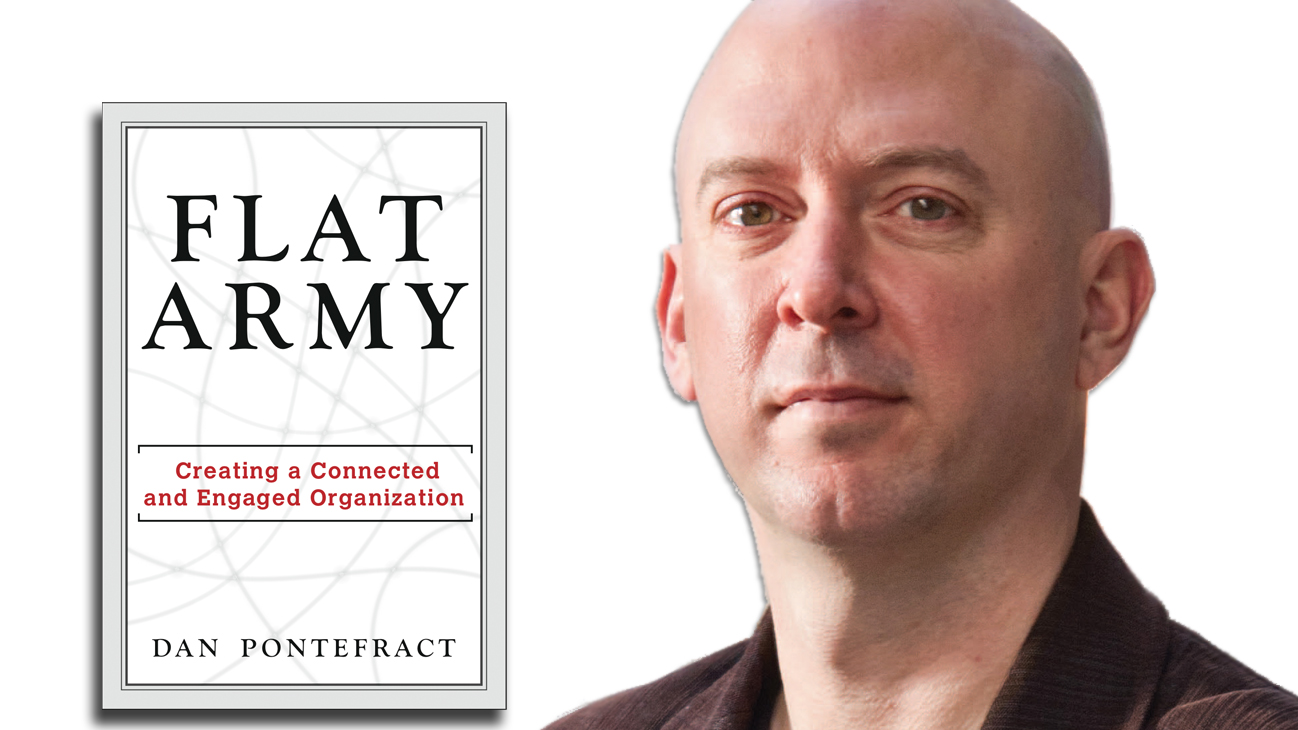Dan Pontefract is the head of learning and collaboration at TELUS, and author of the new book, Flat Army: Creating a Connected and Engaged Organization. In the book, Dan says organizations need to abandon their traditional command-and-control management style and adopt a collaborative, open leadership approach—one that engages and empowers their people. While this isn’t a particularly new idea, many leaders, while they may pay lip service to it, don’t really understand what it means. And most of those who do get it lack the skills for putting it into practice. In Flat Army, Dan shows powerful leadership models and tools that help leaders challenge and overcome their personal obstacles to change, while pushing the boundaries of organizational change to create a culture of collaboration.
Here’s a an excerpt from the first chapter to get you started:
CHAPTER ONE: THE MONA LISA IS SO SMALL!
Have you ever been to the Louvre in Paris?There are those who visit the Louvre to revel in the brilliance of art. There are many, however, whose sole purpose is to rush through the first-floor entrance, plowing past the thirteenth-, fourteenth-, and fifteenth-century Italian paintings to remark out loud, “Wow, the Mona Lisa is so small.” They then proceed to the next Parisian tourist attraction like the Palais-Royal or the Panthéon, saying afterward to their friends,“Yes, I’ve been to the Louvre and have seen the Mona Lisa.”
Those who rush to view only the Mona Lisa at the Louvre are myopic and foolish and akin to much of what is going wrong with leadership today. The current state of leadership should make us fearful. We can’t merely tick the box that states “Mona Lisa” and suggest that we’ve covered the art world. So which type are you? Do you visit the Louvre to prove you’ve seen the Mona Lisa? Or do you savor the experience of being present in the other galleries?
Mike Johnson once said, “The ability to engage employees, to make them work with our business, is going to be one of the greatest organizational battles of the coming ten years.” It’s been nearly a decade since he penned those words in his 2004 book New Rules of Engagement: Life-Work Balance and Employee Commitment. They could have been written today—and perhaps in an even more urgent tone. Leadership models—of which there have been many of late—have failed people and organizations.
We recognize it’s a question of leadership. It’s a question of whether we are embracing the desire of employees to actually be treated like adults. It’s a question of maturity; leaders cannot fathom the loss of control, yet paradoxically, it’s the more creative and less hierarchical leader who is, in fact, empowering his or her team and getting better results.
Organizations realize that success is achieved through effective leadership, but if engaged employees is the primary outcome we desire from effective leadership, then it’s a question of whether we are embracing employees’ desires, first and foremost to be treated like responsible adults. Traditional leaders struggle with this concept as it represents a loss of control for them, but creative, less hierarchical-minded leaders who empower their employees are getting better results, and in turn, are empowered and emboldened to reach for greater successes with their cohort. As I thought through this idea, the notion of Flat Army came to me. Sounds intriguing, doesn’t it?
This book weaves together my thinking around organizations—that they are at an inflection point, and perhaps even a crisis point. When we hear the word “army,” we typically picture images of war in our heads. I, on the other hand, think of fishing boats. The word “army” is derived from armata, a medieval Latin term used first in 1533 to depict a fleet of things moving together—an armada, if you will. This, to me, is the essence of an army—a group of people striving, leading together to achieve a common goal.
We need to move together again as an organization. Leadership doesn’t come from one, it comes from all. This is why the word “flat” comes in front of army. Flat denotes equality and togetherness. In the English language, “flat” can be used in myriad different ways. For purposes of this book—and my central thesis—I use it to define horizontal connectedness.
Flat Army’s audacious goal is to give your organization new life. It aims to free you of the bonds of leadership styles and models that continue to exacerbate disengagement levels of employees, worker dissatisfaction and general innovation malaise. It demonstrates how to both flatten and reunite the armada—and thus the fleet of fishing vessels. The elements of social technologies, collaboration, participation, pervasive learning and connected leadership are frameworks to help both the individual and the organization succeed in the years to come.
Flat Army doesn’t diss situational hierarchy, but an overarching omnipresent hierarchy across the organization, controlled by principles of command and control, is an illogical and unsuitable model in a time when the employee wants to desperately become part of the fishing boat armada. They no longer want to be left ashore.

